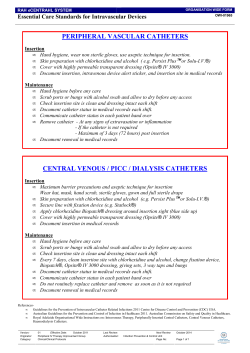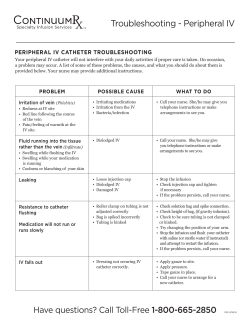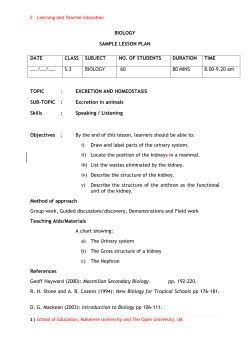
AIM Statement Next Steps Run Chart Reduce CAUTIs from 2011 baseline
Catheter Associated Urinary Tract Infections Reduction Barton Memorial Hospital South Lake Tahoe, CA November, 2014 AIM Statement Run Chart • Continue surveillance. Reduce CAUTIs from 2011 baseline by 40% by December 2014. Baseline = 4.59, AIM = 2.75 by 12/14 2014 YTD Performance: 0 CAUTIs • Revise indwelling urinary catheter insertion bundle to include orders for urine analysis and urine culture with initial insertion. • Develop guidelines for use of silverimpregnated urinary catheters for select highrisk populations. Interventions 2010: Team Members • Workgroup convened. • Patient Safety Officer: Dawn Evans, RN 2011: • Evidence-based review for best practices on usage, product, insertion bundle and insertion technique. • Multiple urinary catheter policies identified throughout hospital. Standardized to one and revised. • Infection Preventionist: Vicki McKenna, RN Data Source: Comprehensive Data System-HRET as of 09-09-2014 • VP Nursing: Sue Fairley, RN • Department Directors: • ED: Beth Brown, RN • Education module with return demonstration developed for new hire orientation. • Home Health/Hospice: Barbara Kaufman, RN • Daily indwelling urinary catheter necessity rounding by Infection Control department staff implemented. • Perinatal Services: Carla Sells, RN 2012: • Quality Management: Christine O’Farrell, RN • Continued surveillance exhibited sustained reduction and compliance. • Outpatient Services: Deborah McCarthy, RN • Workgroup disbanded. 2013: • Order for “Urine analysis, culture if indicated” with initial insertion added to indwelling urinary catheter bundle. 2014: • Workgroup reconvened. • Urinary catheter care once per shift staff reminders. • Re-implement paper indwelling urinary catheter safety insertion checklist. • Skills fair educational update. • Implement use of “Red card”. • Urologist: Dr. Bradley Anderson, MD, FACP • Hospitalist: Dr. Stefan Schunk, MD • Staff education on revised policy, new product, bundle, insertion practices. • Hand Hygiene initiative started with front line staff serving as their departments “hand hygiene champions”. Next Steps • Laboratory Services: Julie Kline • Acute Care: Shannan Birkholm, RN Lessons Learned • Implementation of the electronic medical record led to a loss in the use of the safety insertion checklist tool that is a part of the CAUTI prevention bundle. • Need to obtain urine culture with initial indwelling urinary catheter insertion. • Staff uncomfortable at times approaching others who are noncompliant and having a discussion. Identified the need for a “Red card” that they can hand to the person. This states an opportunity was identified and outlines the correct process. • Clinical Educator: Kelli Teteak, RN • Wound Care Coordinator: Karen Wilson, RN Resources • HQI CAUTI Harm Elimination Toolkit is available on the HQI website at hqinstitute.org < Tools and Resources. • Questions: Contact Mahsa Farahani, Project Manager, HQI at 916-552-7521, email mfarahani@hqinstitute.org.
© Copyright 2025





















